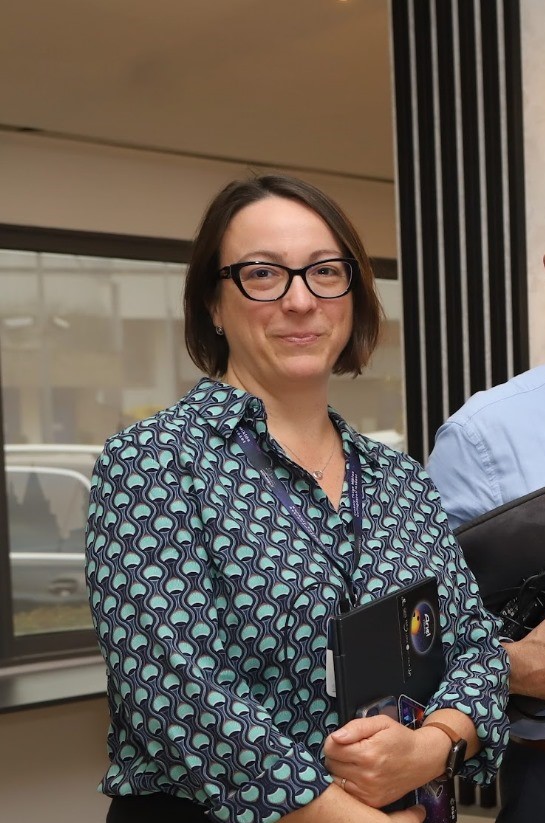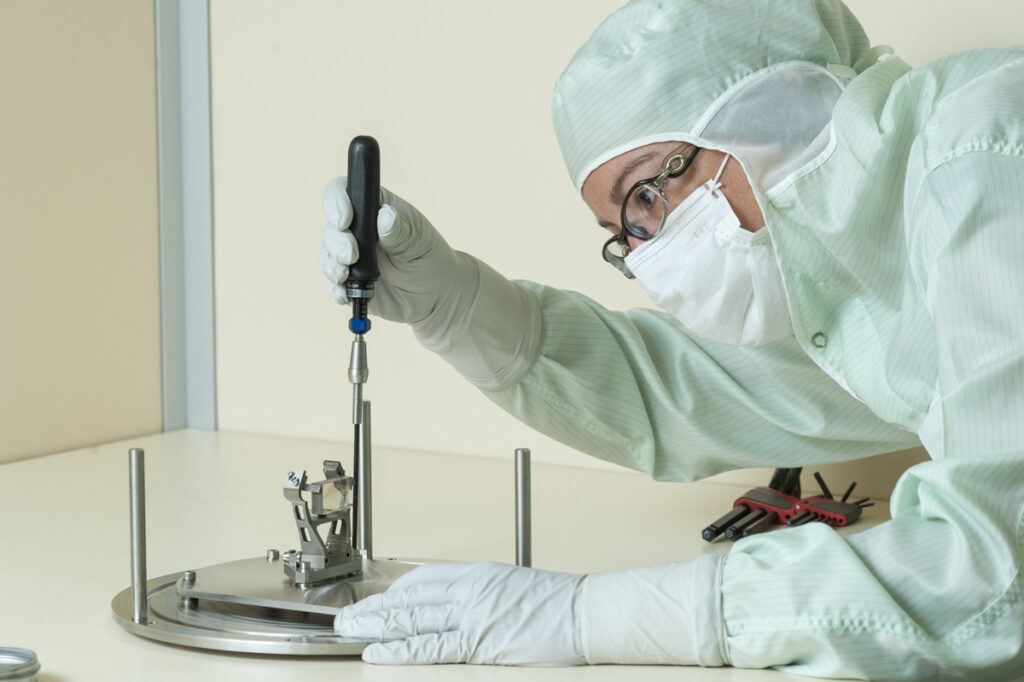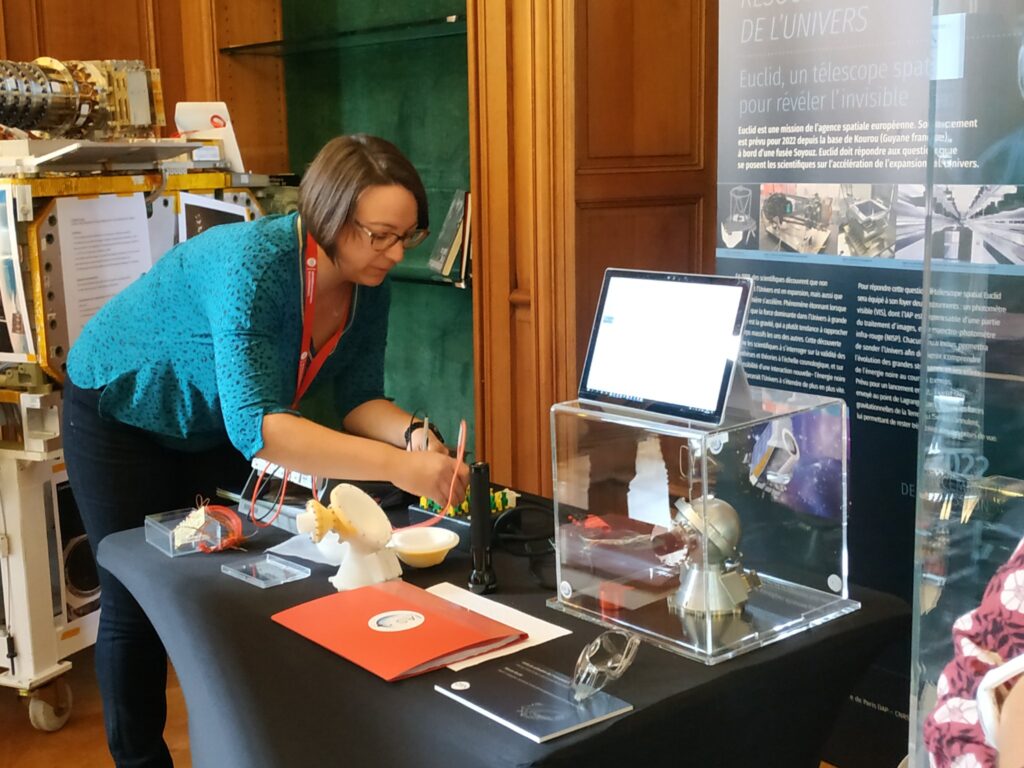Euclid is a space mission planned, built, and operated by more than 2000 scientists and engineers across Europe and other countries. In Portraits of Euclideans we showcase the people behind the mission.
In this portrait: Anne Philippon, Euclid project manager for VIS-CU
- Can you tell us something about your background?
I grew up in the countryside in the North of France. My parents were math teachers, so there was always science at home. After high school, I left for Paris to prepare for the competitive entrance exams to engineering schools for three years. That’s one way of getting into an engineering school in France. You compete with all the students and then choose which engineering school you want to go to. I attended an applied research engineering school specializing in optics, which was in Orsay, where I work now. By the end of engineering school, I knew I wanted to work either on medical or astrophysics, and there was one opportunity to do a PhD at Institut d’Astrophysique Spatiale. So I chose that, and I never left. The PhD was in engineering to develop a new instrument for solar physics research. I enjoy working with the teams at IAS and stayed to work on different instruments.
- What is your role in the Euclid Consortium?
I’m the project manager for the calibration unit for the VIS instrument. I’m not active in the consortium apart from this role in instrumental development. I started working on the calibration unit at IAS in 2015 when we were beginning to develop the structural and thermal model. Nowadays my contribution to Euclid is very small. After the flight model had been delivered, I assisted the teams at Airbus and Thales during the integration and testing before launch. After launch, I also had exchanges with the team from the VIS instrument during the commissioning and the performance verification phase. We asked for some additional data that was not on the data pack for the LEDs in the calibration unit. I gave my opinion on the behavior of the instrument, whether it was normal or not.
- What is the most interesting or exciting thing about your job?
What I really like as an engineer on a space mission and the opportunity I have here is that I can follow the development of an instrument from the first concepts and the first studies to the different models to when it is functioning in space and producing its first results. Thereby, I have been contributing to an instrument that will further our knowledge of the universe. That’s a little bit crazy when you think about it. I was not thinking about that when I was first doing the engineering school. I didn’t dream that one day that could be possible for me. Knowing that something you built with your hands and your team is in space and doing science. Even though I’m not doing the science myself, the scientists from the lab keep me updated on what they do with the data.
- What excites you or interests you most about Euclid specifically?
As an optical engineer, I’m interested in gravitational lensing. I am fascinated by the concept, the fact that it exists, and what scientists do with it.
- What’s the exact function of the calibration unit in Euclid?
The calibration unit is for the VIS instrument. It creates a light beam that allows to do monochromatic flat fields in this focal plane, which are used for the calibration. The idea is you have a very uniform and time-stable monochromatic beam that is the size of the focal plane. With this, you illuminate all detectors in the focal plane and you can monitor and calibrate the difference between pixel-to-pixel response, the non-linearity, and adjust the gain from one quadrant to another.
- Were there any major engineering challenges when building it?
Well, always the two main challenges for Euclid were the qualification of the LEDs and the size of the focal plane of VIS.
The LEDs used for the CU are off-the-shelf components, so they are not made especially for space engineering. Therefore, we had to qualify them for the space environment and the temperature at which the instrument operates, which is 130 Kelvin. It took a lot of testing. We had to procure thousands of LEDs of each type, more types than we ended up using in the CU. We selected nine or ten types of LEDs from a much bigger pool of LEDs. It took several years to test because thousands of LEDs were tested in different configurations, several setups, and a ton of data to analyze. In the final selection, only LEDs for six wavelengths remained and two of each type were put in the CU. So there were 12 LEDs that made it to space, but we procured thousands.
The second challenge was that the focal plane is very wide (35 by 35 centimeters). We needed to map the illumination being produced by the CU to show that it was compliant with the non-uniformity specification. We didn’t have a focal plane of that size in our lab. So we had to scan the beam and it required very precise methodology to be sure what pixel we were looking at which position. We gathered a lot of data as well, and we had a very complex scanning mechanism for the CCD we were using. Additionally, the stray light control of the measurement bench was also difficult to obtain because the flux we wanted to achieve was quite low and we didn’t want to pollute the signal.
- What’s the most notable difference when building instruments for Euclid to other instruments you’ve built?
The CU is pretty much a standalone subsystem. In previous missions, and also in the mission I’m working on now, the subsystem we build, are very integrated in the instruments. There is a need for complex alignment and a lot of discussion with other partners, but in Euclid, it wasn’t the case. Our main collaboration was with the CEA, which developed the focal plane for VIS and that’s a lab just next door.
- Any advice for someone who is considering becoming an engineer?
Every year we have lots of female students that come to the lab or to the university as part of the Women in Science initiative. There I explain how I became an engineer, along with other colleagues from other types of work, such as mechanical, thermal, electrical engineers, … We have a lot of women in the engineering teams at the lab. So we encourage young women to pursue a career in science or engineering, which is still mainly a male-dominated field. I haven’t had any bad experiences, when working with a lot of men. We are telling the young women that they can do it, that it is exciting and they should stay with us.
- What do you do for fun?
I’ve been a volunteer at a cat rescue for like 20 years, which means I have been cleaning up thousands of litter boxes! People usually don’t see that it’s a big part of the volunteer work in an animal shelter. I work there almost every weekend and I do the social media for them. That’s my happy place, being surrounded by cats.





